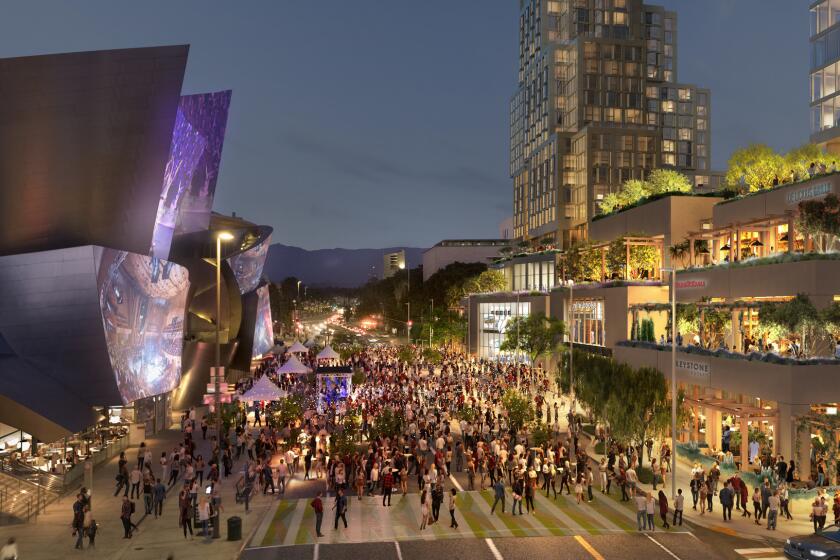Commentary: Frank Gehry unveils designs for two L.A. concert halls. But will they get built?
- Share via
The Grand is rising. And L.A. is beginning to notice.
As the decades-delayed mixed-use facility designed by Frank Gehry begins to take towering, and possibly transformative, shape across the street from his Walt Disney Concert Hall, crucial missing pieces of that transformation are suddenly noticeable: two concert halls and a public plaza by Gehry that are keys to making Grand Avenue an arts arena like none other in America.
With fundraising for the Colburn School project stalled however, Gehry released to The Times images of his concert hall models for the first time. As the architect’s design demonstrates, the two halls could well make or break the promise of the $1-billion Grand. Its developer, Related Cos., is providing restaurants, shops, movie theaters, a hotel and an apartment tower. Closely relating the proposed Colburn halls to the Grand bestows on Related a heart and soul.
In the current rendition, the Colburn structure abuts the rear of the Grand on what is now a parking lot at Olive and Second streets. Gehry’s plan calls for a glass-enclosed, 1,100-seat concert hall on one end, plus a boxy 700-seat theater for dance, chamber opera and experimental performance work. A founders room and roof terrace could further serve as a facility for late-night cabaret and edgy work. A glassy lobby brings all the audiences together.
The interiors for the two halls, which are collaborations with the celebrated Disney Hall acoustician Yasuhisa Toyota, are very different. The larger one will be in the round, almost like a larger version of Gehry’s recent Pierre Boulez Saal in Berlin, providing a sense of immediacy. It has the potential for not only serving the Colburn School orchestral performance needs (Esa-Pekka Salonen has become director of the conducting department) but also providing a new home for Los Angeles Chamber Orchestra, hosting recitals and, as has been a brilliant feature of the Boulez Saal, supplying a perfectly sized, intimate showcase for performing arts from a variety of cultures.
The smaller hall features a steep rake and stage with a small pit. Los Angeles Opera Music Director James Conlon and L.A. Dance Project founder Benjamin Millepied see this as a vital facility for their organizations and for collaborations with Colburn. It could just as importantly welcome dance and musical theater created in L.A.’s diverse communities.
Build Frank Gehry’s Colburn School concert hall. Renovate Disney Hall. Update the Dorothy Chandler Pavilion. The investments will pay off, big time.
The facing plaza is dominated by an immense video screen and revolutionary sound system allowing for projections of performances inside or serving as another stage for live events. The plaza physically and artistically connects to the nearby Museum of Contemporary Art, the Broad museum and Disney Hall, and it is designed to add a measure of street life that’s lacking on Bunker Hill, with its bunkered buildings. The glass exterior of the new building not only will be a window into the larger hall, lobby and dance studios at ground level but will allow “sound leakage” to passersby and permit musicians to step out onto platforms and be part of outdoor events.
Coronavirus may have silenced our symphony halls, taking away the essential communal experience of the concert as we know it, but The Times invites you to join us on a different kind of shared journey: a new series on listening.
Gehry said this new arts complex will cost $310 million. While noting the civic value, to say nothing of its enhancement of educational programs, the Colburn School acknowledged in a statement that it’s grappling with the financial impact of the present and the uncertainty of the future and that it “has decided to pause any further development of the project for an indefinite period of time.” But in a phone conversation, Colburn’s president and chief executive, Sel Kardan, said were a major donor to come along, the project could certainly be revived and that nothing is off the table in considering various public and private proposals.
Without the halls and the plaza, Grand Avenue is a collection of buildings. The Grand is a giant commercial enterprise that in the worst of all possible worlds could become L.A.’s Hudson Yards, the Related development in New York that even with its performing arts space, the Shed, is a soulless, high-roller monument to income inequality. What do we want for L.A.?
More to Read
The biggest entertainment stories
Get our big stories about Hollywood, film, television, music, arts, culture and more right in your inbox as soon as they publish.
You may occasionally receive promotional content from the Los Angeles Times.













